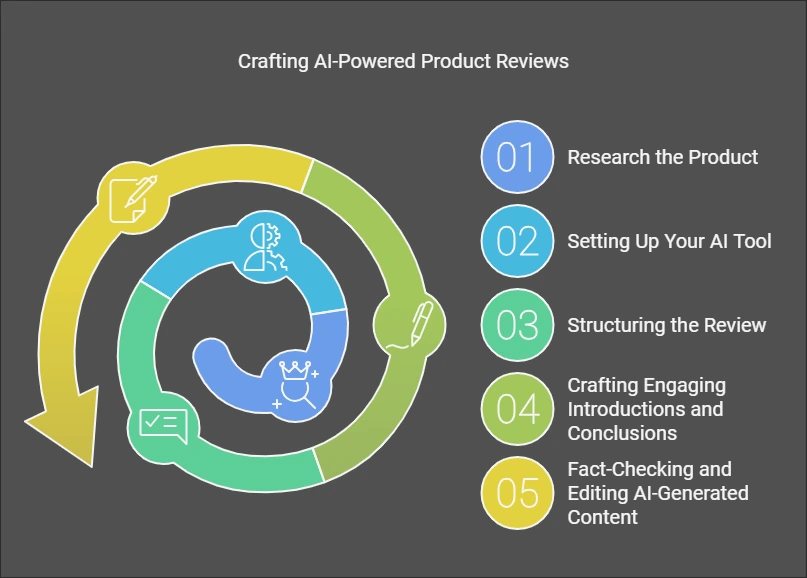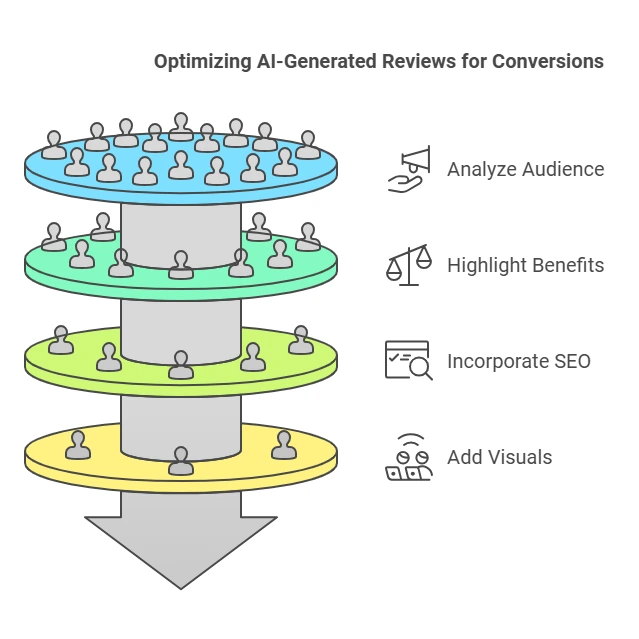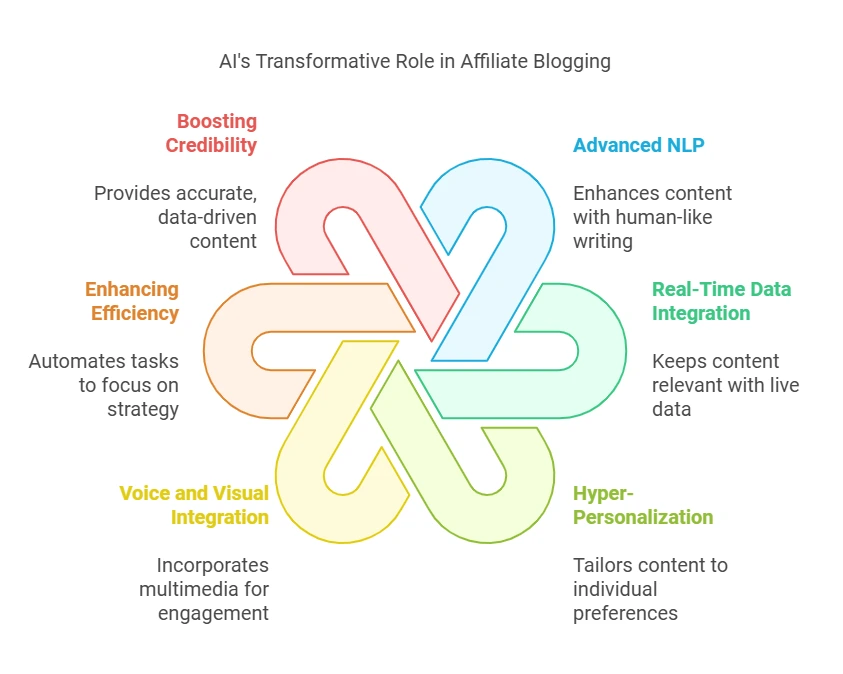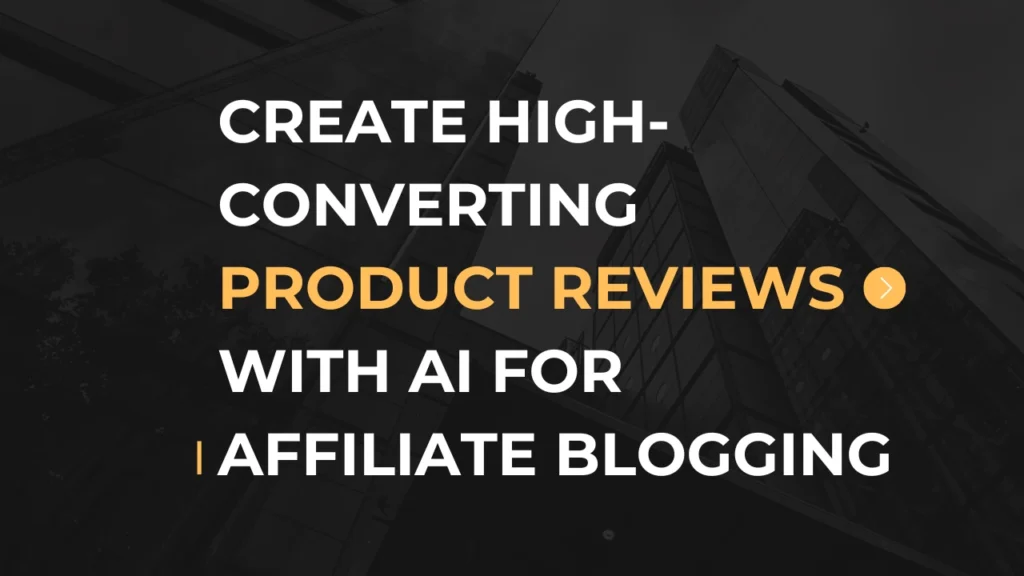Table of Contents
Love this post? Share it!
Introduction
Affiliate blogging is one of the most effective ways to earn passive income online, and product reviews are its backbone. A well-crafted review not only informs readers but also builds trust and drives conversions. However, creating compelling, authentic reviews consistently can be challenging, especially in a competitive landscape. This is where AI steps in as a game-changer. By combining the power of artificial intelligence with a structured approach like the MECE framework, affiliate marketers can produce high-converting product reviews that captivate audiences and increase sales.
Why Product Reviews Matter in Affiliate Blogging
Product reviews are more than just summaries of features—they are persuasive narratives that address customer pain points, answer critical questions, and highlight the value of a product. When done right, reviews can:
- Establish credibility and authority for the blogger.
- Help readers make informed purchasing decisions.
- Drive affiliate sales through strategically placed links.
In essence, product reviews are the bridge between a reader’s curiosity and a confident purchase decision, making them indispensable for affiliate success.
The Rise of AI in Affiliate Marketing
AI technology has revolutionized the way content is created. From generating high-quality written content to personalizing user experiences, AI offers a suite of tools that streamline the content creation process. For affiliate marketers, AI can:
- Automate mundane tasks like keyword research and outline generation.
- Produce engaging, optimized content quickly.
- Personalize product reviews based on audience preferences.
This means bloggers can focus more on strategy and audience engagement while relying on AI to handle the heavy lifting of content creation.
Want to leverage AI to build a profitable online business but don’t know where to start? 🚀 Our beginner-friendly guide walks you through everything you need to know to launch and scale with AI. Don’t miss out—grab your copy of “How to Build an AI-Powered Online Business: A Beginner’s Guide” today! 👉 Get your eBook now!
Overview of the MECE Framework and Its Relevance
The MECE (Mutually Exclusive, Collectively Exhaustive) framework ensures that content is well-organized, clear, and comprehensive. By structuring reviews using MECE principles, affiliate marketers can avoid redundancy, cover every critical aspect of a product, and present information in a logical flow. This not only enhances readability but also boosts the likelihood of conversions.
Part 1: Understanding High-Converting Product Reviews
What Makes a Product Review High-Converting?
Building Credibility
Trust is the foundation of any successful affiliate blog. Readers are more likely to follow recommendations from a source they perceive as authentic and knowledgeable. Including personal experiences, verified customer testimonials, and unbiased evaluations can significantly enhance credibility.
Providing Comprehensive and Honest Insights
A high-converting review goes beyond surface-level details. It should delve into the product’s features, performance, and any potential drawbacks. Transparency is key—acknowledging a product’s limitations alongside its benefits makes the review feel genuine and relatable.
Focusing on Benefits and Use Cases
Readers care more about what a product can do for them than its technical specifications. A great review highlights the product’s practical applications and the specific problems it solves. Tailoring these benefits to your audience’s needs can make your review more impactful.
Common Challenges in Writing Product Reviews
Lack of Authenticity
Overly promotional or generic reviews can turn readers away. Authenticity requires a balanced perspective that addresses both the strengths and weaknesses of a product.
Incomplete Information
A review that omits crucial details leaves readers with unanswered questions, reducing trust and engagement. Comprehensive research is vital to avoid this pitfall.
Ineffective Call-to-Actions
Even the most compelling review won’t convert without a clear next step. A weak or absent call-to-action (CTA) can cause readers to leave without making a purchase.
Part 2: Leveraging AI for Product Reviews
AI Tools for Affiliate Blogging
Overview of Popular AI Writing Tools
AI tools like ChatGPT, Jasper, and Writesonic have become indispensable for affiliate bloggers. These tools can generate high-quality content, suggest keywords, and even refine tone and style to suit your audience.
Struggling to create SEO-optimized articles, blog posts, or affiliate content effortlessly? ✍️ Try this powerful AI writing tool that generates high-quality content in 1 click, supports 48 languages, and even auto-posts to WordPress with AI-generated images! 🚀 Boost your content game today! 👉 Try it now!
Comparing AI Tools for Review Generation
Each tool has its strengths. For instance, ChatGPT excels at creating conversational content, while Jasper offers advanced templates for structured reviews. Choosing the right tool depends on your specific needs and goals.
Benefits of Using AI in Affiliate Blogging
Time Efficiency
AI significantly reduces the time spent on content creation by automating tasks like research, drafting, and editing. This allows bloggers to focus on strategy and audience engagement.
Enhanced Content Personalization
AI can tailor reviews based on audience preferences, such as emphasizing specific features or addressing common concerns. This personalization makes the content more relevant and engaging.
Improved SEO Optimization
With built-in features for keyword research and on-page optimization, AI ensures that your content ranks higher in search results, driving more organic traffic to your blog.
By combining AI technology with proven strategies, affiliate marketers can create product reviews that not only resonate with readers but also drive significant revenue. The following sections will delve deeper into actionable steps and best practices to help you succeed.
Part 3: Step-by-Step Guide to Crafting AI-Powered Product Reviews

Creating compelling, high-converting product reviews using AI is easier when you follow a structured approach. Here’s a step-by-step guide to help you craft reviews that captivate readers and drive conversions.
Step 1: Research the Product
Gathering Essential Product Information
Before diving into AI-assisted writing, start with thorough research. Understand the product inside and out by:
- Reading official product descriptions and specifications.
- Exploring user reviews and testimonials to gauge real-world experiences.
- Watching demonstration videos or tutorials for a hands-on perspective.
This foundational knowledge ensures your review is accurate, comprehensive, and resonates with your audience.
Identifying Unique Selling Points
Focus on what sets the product apart from competitors. Is it a groundbreaking feature? Superior quality? Exceptional value for money? Highlighting these unique aspects makes your review stand out and persuades readers to consider the product.
Step 2: Setting Up Your AI Tool
Choosing the Right Tool for Your Needs
Different AI tools cater to different needs. Tools like ChatGPT, Jasper, and Writesonic offer various features for generating content. Choose one that aligns with your goals, whether it’s conversational writing, SEO optimization, or advanced templates.
Configuring Templates for Review Writing
Most AI tools allow you to customize templates to fit your review structure. Configure your tool to include:
- An engaging introduction.
- Key product features and benefits.
- Balanced pros and cons.
- A strong conclusion with a clear call-to-action.
This setup ensures consistency and saves time when creating multiple reviews.
Step 3: Structuring the Review
Using the MECE Framework for Logical Flow
Apply the MECE (Mutually Exclusive, Collectively Exhaustive) framework to organize your review logically. Break the content into distinct sections, such as:
- Overview of the product.
- Benefits and key features.
- Pros and cons.
- Who it’s best suited for.
This clarity helps readers quickly find the information they need, keeping them engaged.
Balancing Pros, Cons, and Features
Honesty is crucial for credibility. While highlighting the product’s strengths, don’t shy away from mentioning its drawbacks. Balance the discussion with an emphasis on how the pros outweigh the cons, making your review both authentic and persuasive.
Step 4: Crafting Engaging Introductions and Conclusions
Writing Attention-Grabbing Headlines
Your headline is the first thing readers see, so make it count. Use powerful words, numbers, or questions to pique curiosity. For example:
- “5 Reasons Why [Product Name] is a Game-Changer for [Audience]”
- “Is [Product Name] Worth the Hype? A Detailed Review”
Ending with Clear Call-to-Actions
The conclusion should leave readers with no doubt about the next step. Use strong, actionable phrases like:
- “Click here to buy [Product Name] and experience its benefits today!”
- “Don’t miss out—get your hands on [Product Name] now!”
Clear CTAs drive conversions and guide readers seamlessly toward the purchase.
Step 5: Fact-Checking and Editing AI-Generated Content
Ensuring Accuracy and Authenticity
AI-generated content is a starting point, not the final product. Double-check all facts, data, and claims to ensure accuracy. Cross-reference with reliable sources to build trust with your readers.
Adding Personal Insights for a Human Touch
While AI can create polished content, adding your own voice and experiences makes the review more relatable. Share your thoughts, anecdotes, or practical tips about the product. This human touch fosters connection and authenticity.
By following these steps, you can harness the power of AI to produce product reviews that are not only high-quality but also engaging and conversion-focused. The result? A loyal audience and a thriving affiliate blogging business.
Part 4: Optimizing AI-Generated Reviews for Conversions

Creating AI-generated product reviews is just the first step; optimizing them for maximum conversions is where the real impact lies. Here’s how to refine your reviews to better connect with your audience and drive action.
Using Data to Tailor Reviews to Your Audience
Analyzing Audience Pain Points
Understanding your audience’s challenges is crucial. Use tools like Google Analytics, audience surveys, or keyword research to uncover:
- The problems they’re looking to solve.
- Specific features or benefits they value most.
Addressing these pain points in your reviews makes your content more relevant and engaging.
Highlighting Benefits Relevant to Readers
Focus on how the product solves your audience’s specific issues. Instead of listing features, explain the benefits those features provide. For example:
- Instead of: “The blender has a 1200-watt motor.”
- Say: “With its powerful 1200-watt motor, this blender effortlessly crushes ice, saving you time and effort in making smoothies.”
Incorporating SEO Best Practices
Choosing Target Keywords
Optimize your reviews by integrating relevant keywords that align with what your audience is searching for. Use tools like Google Keyword Planner or Ubersuggest to find terms with high search volume and low competition.
Crafting Meta Descriptions and Titles
Your meta title and description are the first things users see on search engines. Write compelling, keyword-rich snippets to boost click-through rates. For example:
- Meta Title: “Is [Product Name] Right for You? A Comprehensive Review”
- Meta Description: “Discover the features, benefits, and real-world performance of [Product Name] in this detailed review tailored to your needs.”
Visual Enhancements for Engagement
Adding High-Quality Images and Videos
Visuals significantly boost engagement. Include:
- Crisp, clear images of the product from various angles.
- Demonstration videos showing the product in action.
These elements build trust and provide a better understanding of the product’s usability.
Using Infographics for Feature Comparisons
Infographics are an excellent way to summarize key product features and compare them with competitors. They make complex information digestible and visually appealing, increasing shareability and reader retention.
Part 5: Best Practices and Case Studies
Even with AI’s capabilities, success in affiliate blogging requires following best practices and learning from those who’ve excelled in the field.
Dos and Don’ts of AI-Powered Product Reviews
Dos
- Do personalize AI-generated content: Add your voice, experiences, and anecdotes to make reviews relatable.
- Do use the MECE framework: Keep your reviews organized and easy to navigate.
- Do focus on benefits: Highlight how the product improves the reader’s life rather than just listing features.
Don’ts
- Don’t rely solely on AI: Always fact-check and enhance the content with human insights.
- Don’t exaggerate: Overhyping a product can lead to mistrust and harm your credibility.
- Don’t ignore SEO: AI tools may miss critical SEO opportunities, so always optimize your content manually.
Common Mistakes to Avoid
- Generic Content: Avoid creating reviews that lack depth or specificity.
- Overlooking CTAs: A review without a strong call-to-action may lose potential conversions.
- Ignoring Feedback: Pay attention to reader comments and adjust your approach accordingly.
Tips for Maintaining Authenticity
- Be Honest: Acknowledge both the pros and cons of a product. Readers appreciate transparency.
- Use Real-World Scenarios: Illustrate how the product fits into daily life or solves common problems.
- Engage with Your Audience: Respond to comments and encourage discussions around your reviews.
Success Stories: High-Converting AI Reviews in Action
Real-Life Examples of Successful Affiliate Blogs
- Tech Guru Blog: Leveraging AI to create in-depth reviews of gadgets, this blog achieved a 40% increase in affiliate revenue by tailoring content to tech enthusiasts.
- Fit & Fab Living: With AI-generated comparisons of fitness equipment, this blog tripled its traffic by combining infographics and engaging storytelling.
Lessons Learned from Top Performers
- Know Your Niche: Successful bloggers focus on a specific audience and cater to their unique needs.
- Invest in Quality Tools: High-performing blogs use advanced AI tools to generate polished content.
- Experiment and Optimize: Top bloggers continually test headlines, layouts, and CTAs to improve performance.
By following these practices and learning from proven examples, you can transform AI-generated reviews into high-converting, impactful content that grows your affiliate blogging success.
Part 6: Future Trends in AI and Affiliate Blogging

As AI technology evolves, its impact on affiliate blogging continues to grow. From smarter tools to more personalized content, the future holds exciting possibilities for bloggers leveraging AI.
Emerging AI Features to Watch For
- Advanced Natural Language Processing (NLP)
AI tools are becoming better at understanding context and mimicking human-like writing styles. Future iterations may provide even more nuanced, conversational, and audience-specific content. - Real-Time Data Integration
Soon, AI tools could integrate real-time market trends, customer reviews, and competitor insights directly into content creation. This feature would allow bloggers to produce reviews that are always up-to-date and highly relevant. - Hyper-Personalization
AI is moving toward delivering tailored content that resonates with individual audience segments. Tools may analyze user behavior and preferences to create product reviews that feel uniquely crafted for each reader. - Voice and Visual Integration
Expect AI to incorporate voice-based reviews and interactive visuals, like product demos or 3D previews, into the blogging experience. This multimedia approach could make content more engaging and accessible.
How AI is Shaping the Future of Product Reviews
AI is not just a tool; it’s becoming a collaborator for affiliate bloggers. It’s reshaping the content creation process by:
- Enhancing Efficiency: Automated content generation allows bloggers to focus more on strategy and engagement.
- Boosting Credibility: AI tools equipped with real-time data analysis provide fact-based, accurate content.
- Enriching User Experience: AI’s ability to generate personalized, engaging, and visually appealing reviews elevates the reader experience.
These advancements mean that bloggers who embrace AI will have a competitive edge in the ever-evolving affiliate marketing landscape.
Conclusion
Recap of Key Insights on AI-Powered Product Reviews
Throughout this guide, we’ve explored the transformative power of AI in creating high-converting product reviews. Key takeaways include:
- The importance of well-structured, credible reviews in affiliate blogging.
- How AI tools save time, enhance personalization, and improve SEO.
- The value of combining AI with frameworks like MECE for organized and effective content.
AI is a powerful ally, but success lies in how you use it.
Encouragement to Experiment and Optimize
The world of AI is dynamic and full of potential. Don’t be afraid to experiment with different tools, templates, and strategies. Test, refine, and optimize your approach to discover what resonates best with your audience. With the right blend of AI and human effort, you can create impactful, high-converting reviews that drive affiliate success.
FAQs
Can AI replace human effort in affiliate blogging entirely?
No, AI is a tool to enhance productivity, not a replacement for human creativity and judgment. While it can streamline content creation, human insights, authenticity, and strategic thinking are irreplaceable.
What is the best AI tool for creating product reviews?
There isn’t a one-size-fits-all answer. Tools like ChatGPT, Jasper, and Writesonic excel in different areas, such as conversational writing, structured templates, or SEO optimization. Choose based on your specific needs and goals.
How can I ensure AI-generated content is authentic?
Fact-check AI-generated content, incorporate personal insights, and maintain a balanced perspective. This human touch ensures authenticity and builds trust with readers.
What are the risks of relying on AI for product reviews?
Over-reliance on AI can lead to generic or inaccurate content, reduced authenticity, and a lack of unique voice. Always review and edit AI outputs to align with your brand and audience expectations.
Is AI-generated content effective for SEO?
Yes, AI can improve SEO by incorporating relevant keywords, optimizing structure, and enhancing readability. However, for best results, combine AI-driven optimization with human creativity and a deep understanding of your audience.
By embracing AI’s potential and continuously refining your approach, you can stay ahead in the competitive world of affiliate blogging. The future is bright for those willing to innovate and adapt.

